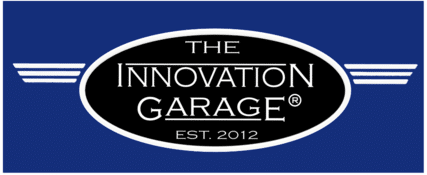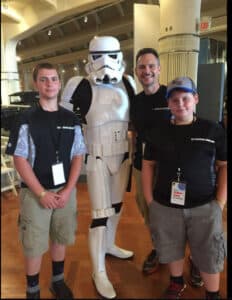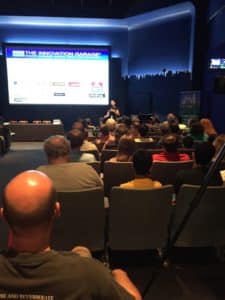For the last few years, my sons and I have had a very special opportunity to hang out and share what we know at one of the coolest places to see and learn about innovation, MakerFaire Detroit at The Henry Ford.
Last year, The Innovation Garage® gave a talk on start-up basics, so check out that post or video here if you’d like to learn more on that subject matter.
MakerFaire represents a neat opportunity for us to hang out together, see some cool sciencey stuff that we can apply in the garage or any side projects we might be doing.
This Saturday, 12:15PM EST join us as we’ll be hanging out again live on the Innovation Nation stage, talking about what we are learning, and sharing it all with the maker community. Come visit if you can.
If you have some questions you’d like to ask for this year’s talk that may be helpful to others, please include them in the comments to @Innov8ionGarage on twitter, or an email to [email protected] and we’ll make sure we capture them in the content this weekend.
So What’s in the Power of The Prototype?
We see seven steps (or habits, if you will) for prototyping, proven to drive long term growth. What we’ve always found interesting is that the steps below apply to a new idea, a start-up company, or an established business looking to do new things, ways to scale and grow…regardless of company size, industry or for-profit/non profit tax classification.
As we work with our client companies with Innovation Education and capability builds, some of the very basics on prototyping come from Innovation Engineering® Systems Driven Leadership.
This is extremely fresh in our minds as we just demo’d a works like prototype this week with a collaboration partner to a client. The prototype makes it real. It can seal the deal, or kill the deal. The prototype can take fear away AND be a powerful visual to show others what’s possible.
The backstory with this particular idea came from a senior executive who saw a problem and sketched a solution. The team evaluated the concept as designed and saw there wasn’t much opportunity to make a meaningful product. The team put together a create and invent session to make the idea more unique and came up with 23 ways to do so. Out of that session came 6 trademarks and 4 provisional patent applications.
Based on our own learning cycles with several clients over the past 12 months, we’ve added a few more elements to round out the prototyping steps and capture more of the full end game.
Who’d have known the letter “P” would be so important when it comes to Innovation.
Step 1: Problem – Make sure you can identify and clearly communicate to your customers the problem that your offering is solving.
Step 2: Promise – It’s the benefit promise of what the offering will do, or the problem it will solve. Don’t focus on the features as much as the benefit for the customer.
Step 3: Proof – How will your solution solve the problem for your customer? Prove this will real test data, testimonials or demos to show how it delivers on the benefit promise.
Step 4: Prototype – Key types we teach and encourage are:
The written concept – Never underestimate the power of the written concept of your idea. Writing a narrative on the above helps to give tremendous clarity on your idea concept.
Looks-Like Prototype – A very simple prototype. Paper. Tape. Cardboard. Glue. Simple Code. Simple App. Here you wave your hands a lot and say “it looks kinda like this and works kinda like this.”
Works-Like Prototype – A prototype that still is very basic, but actually works as intended. Use as many off the shelf parts, pieces, code, or apps to show “how it works.”
Alpha, Beta, and First Release – Once in a formal development process, these are some common steps.
Step 5: Patent – Investigate the benefit of patenting your idea.
Some Basics to understand. There are 3 key types. The USPTO website has some great resources to review. Consult a patent agent or attorney to help guide the process for you.
Provisional Patents – Are a 12 month period to get your formal patent application together. File Provisional applications very quickly. File to first is the rule and first to file owns the claims being patented. This means you can claim “patent pending” and talk to others about your concept. Inexpensive to do and once you do a few, you can file in less than a day.
Design Patents – These patents are most often used for how something looks. These are usually granted about 90% of the time, first pass by the USPTO.
Utility Patents – These patents are “how it works”. 90% of these patents are usually require a few rounds of back and forth with the patent office before a formal grant of patent. Due to backlog at the USPTO, this process in total can take 3-5 years.
Patent Valuation – As a patent is real and tangible property, you should have a valuation assigned to them. No one puts their house up for sale, or their car on craigslist without an understanding of what the property is worth. The same hold’s true for patents. If you understand the valuation of your patent, you can find the right buyer and close a fair deal for both parties.
Step 6: Pitch – Time to pitch. Both to customers and to investors.
Pitch your problem, promise, proof. Focus on how to you will sell to generate cash flow. Cash flow is the life blood of the start-up. Cash flow first, then profits after that.
You may need capital and funds to scale up from where you are. The easiest way is to get some pre-orders. To do that, find a willing customer that will buy some. This demonstrates to others that people are interested in your idea, by buying it.
Then you can look to Corporate Venture Funds or social media crowdsourcing like Kickstarter or Indiegogo to help scale investment.
Rehearse and practice your pitch.
Be prepared for tough questions. Be prepared to say yes. Don’t ever underestimate how a simple yes will help get you to where you want to go.
We’ve witnessed inventors with great ideas and patent protected portfolio’s loose deals to bring their product to market because they hesitate to say yes.
Be positive, look to the bigger picture, and say YES.
Step 7: Pivot – Learn in small steps and pivot as you go. You came up with this great idea for this product, business or service.
If it doesn’t work take what you learn from the above steps, shape shift and change the prototype. You were smart and brave enough to come up with the first idea, we’re absolutely certain you can take what you learn and make it even better.
Repeat.
At The Innovation Garage®…
We help companies become more profitable. We build strategy. We build ideas and coach innovation capability of teams. We design products, services and supply chains. We guide leaders from startup to the Global Fortune 50 to intentionally self-disrupt their offerings and companies. We provide world class education, tools and technology on how to craft business operating systems focused on long-term profitable growth.



